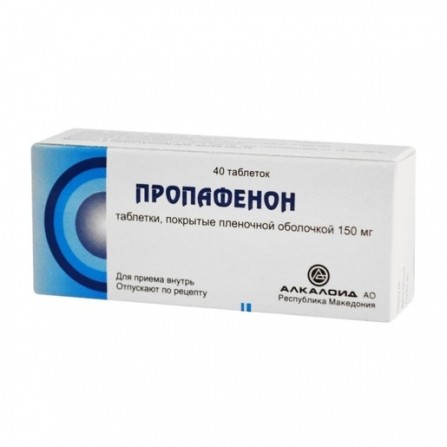Propafenone coated pills 150mg N40
Condition: New product
1000 Items
Rating:
Be the first to write a review!

More info
Active ingredients
Propafenone
Release form
Pills
Composition
Propafenone hydrochloride 150 mg
Pharmacological effect
Antiarrhythmic agent class I C, sodium channel blocker. Reduces the maximum rate of depolarization of phase 0 of the action potential and its amplitude mainly in Purkinje fibers and contractile fibers of the ventricles, reduces automatism. Highly effective in ventricular arrhythmias; with supraventricular arrhythmias, the efficacy is somewhat lower. Propafenone has a mild beta-adrenoceptor blocking effect.
Pharmacokinetics
The pharmacokinetics of propafenone are characterized by significant individual differences. After ingestion, absorption is rapid and almost complete - more than 90%, Cmax in the blood plasma is reached in 1-3.5 hours. 97% binding to proteins. It is extensively metabolized during the "first pass" through the liver to form 2 active metabolites - 5-hydroxypropanone and N-despropylpropafenone, which have antiarrhythmic activity comparable to that of propafenone, but present in concentrations of 20% of the concentrations of propafenone. T1 / 2 in patients with intensive metabolism (more than 90% of cases) - 2-10 hours, with delayed metabolism (less than 10% of cases) - 10-32 hours. Excreted by the kidneys - 38% as metabolites, 1% - unchanged; through the intestines - 53% in the form of metabolites.
Indications
Treatment and prevention of supraventricular and ventricular extrasystoles, paroxysmal arrhythmias (supraventricular tachycardia, including with WPW syndrome; ventricular tachycardia).
Contraindications
Severe forms of chronic heart failure, severe hypotension, cardiogenic shock, severe bradycardia, SSS, AV block II and III degree, electrolyte imbalance, myasthenia gravis, severe obstructive pulmonary disease, hepatic cholestasis, children, hypersensitivity to propafenone.
Use during pregnancy and lactation
Use during pregnancy is possible only when the intended benefit to the mother outweighs the potential risk to the fetus. If necessary, use during lactation should decide whether to stop breastfeeding.
Dosage and administration
When ingestion, the initial dose is 450-600 mg / day, if necessary, the dose is increased to 900 mg / day; With intravenous drip, the initial dose is 500 μg / kg, if necessary, the dose is increased to 1-2 mg / kg.
Side effects
On the part of the cardiovascular system: possible bradycardia, slowing of sinoatrial, AV and intraventricular conduction, reduction of myocardial contractility (in susceptible patients), arrhythmogenic effect; when taken in high doses - orthostatic hypotension; On the part of the digestive system: when taken in high doses, nausea, anorexia, a feeling of heaviness in the epigastrium, constipation; rarely, liver dysfunction. On the CNS side: when taken in high doses, headache, dizziness; rarely - visual impairment. On the part of the hematopoietic system: leukopenia, agranulocytosis, thrombocytopenia.; On the part of the reproductive system: oligospermia. Allergic reactions: rarely - skin rash.
Overdose
Symptoms: decreased blood pressure, drowsiness, confusion, bradycardia, violations of intra-atrial and intraventricular conduction, coma, convulsions, extrapyramidal disorders, ventricular tachyarrhythmias, asystolia.; Treatment: gastric lavage, defibrillation, administration of dobutamine, diazepam; if necessary, mechanical ventilation and indirect heart massage. Hemodialysis is ineffective.
Interaction with other drugs
With simultaneous use with anticholinergic agents, it is possible to enhance the anticholinergic action. With simultaneous use with anticholinesterase agents (including with pyridostigmine), the effectiveness of pyridostigmine in myasthenia decreases; action of propafenone with ventricular arrhythmias.; With simultaneous use of propafenone can potentiate the effect of indirect x anticoagulants. In an application with phenobarbital propafenone increased excretion from the organism decreases and its concentration in the blood plasma. Other barbiturates are believed to interact with propafenone in the same way. When used with ketoconazole, a case of seizures has been described.blood plasma propranolol, metoprolol, cyclosporine, digoxin.; With simultaneous use with rifampicin, the concentration of propafenone in the blood plasma decreases and its therapeutic efficacy is significantly reduced. This is due to the fact that rifampicin induces CYP3A4 / 1A2 isoenzymes and phase II glucuronization of propafenone. Rifampicin does not affect the metabolism of propafenone, due to the activity of the CYP2D6 isoenzyme.; When applied simultaneously, there are described cases of increasing theophylline concentration in the blood plasma and the development of toxic reactions. in blood plasma. The effectiveness of propafenone does not change, because the production of its active metabolite (5-hydroxypropafenone) is simultaneously reduced by 2 times.; Quinidine increases the beta-blocking effects of propafenone in individuals with a high level of metabolism in the liver, because only the original active substance, not metabolites, has beta-blocking activity.; When used simultaneously with cimetidine, a slight increase in the concentration of propafenone in the blood plasma and expansion of the QRS complex on the ECG are possible;
special instructions
It is used with caution in abnormal liver function, pronounced impaired renal function, as well as in combination with other antiarrhythmic agents with similar electrophysiological parameters. Treatment should be started in the hospital because of the increased risk of arrhythmogenic effects associated with the use of propafenone. It is recommended that prior antiarrhythmic therapy be discontinued before starting treatment with propafenone in terms of 2-5 T1 / 2; Propafenone is characterized by pronounced individual differences in plasma concentrations of the active substance, therefore careful selection of doses for each patient is recommended. the introduction should be carried out under the constant control of blood pressure, heart rate and ECG. If during a course of treatment or on the background of intravenous injection, a broadening of the QRS complex or QT interval is noted by more than 20%, compared with baseline values, reduce the dose or temporarily cancel propafenone.In older patients, patients with a body weight less than 70 kg, propafenone is used in lower doses.; Effect on ability to drive vehicles and control mechanisms; It is used with caution in patients engaged in potentially hazardous activities requiring increased attention and quickness of psychomotor reactions.





